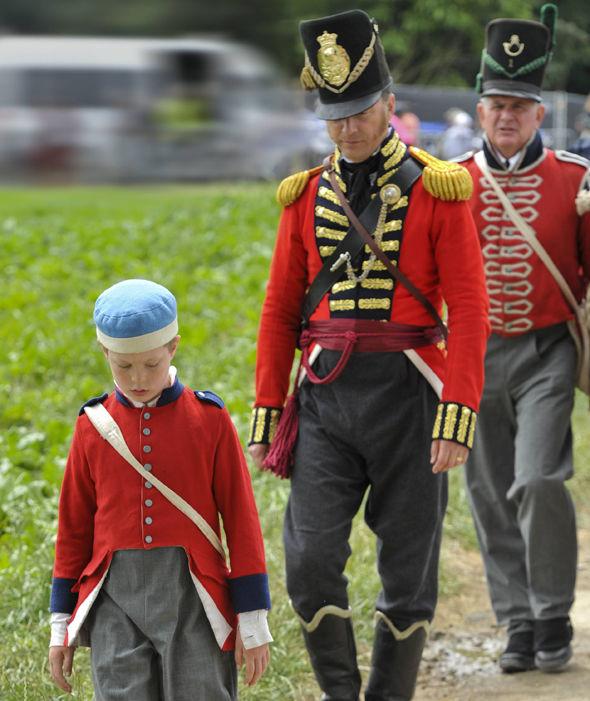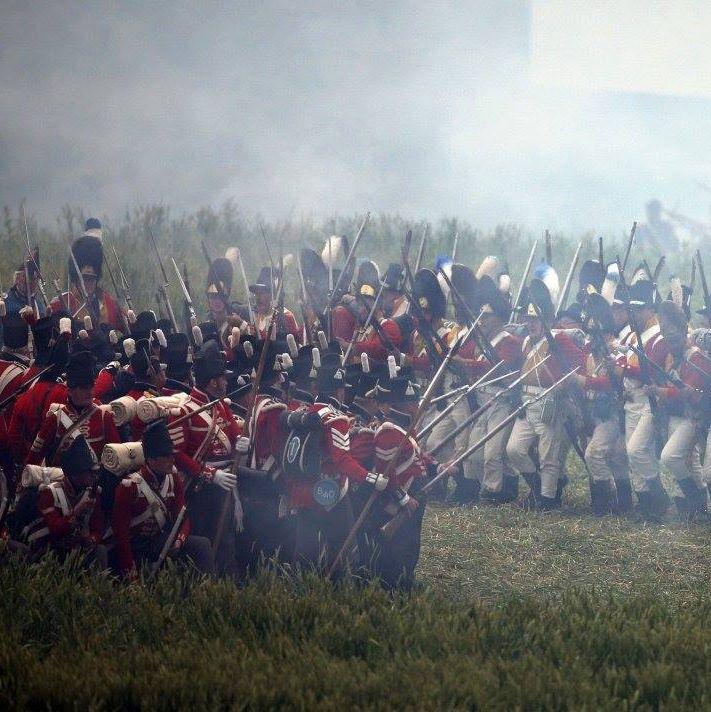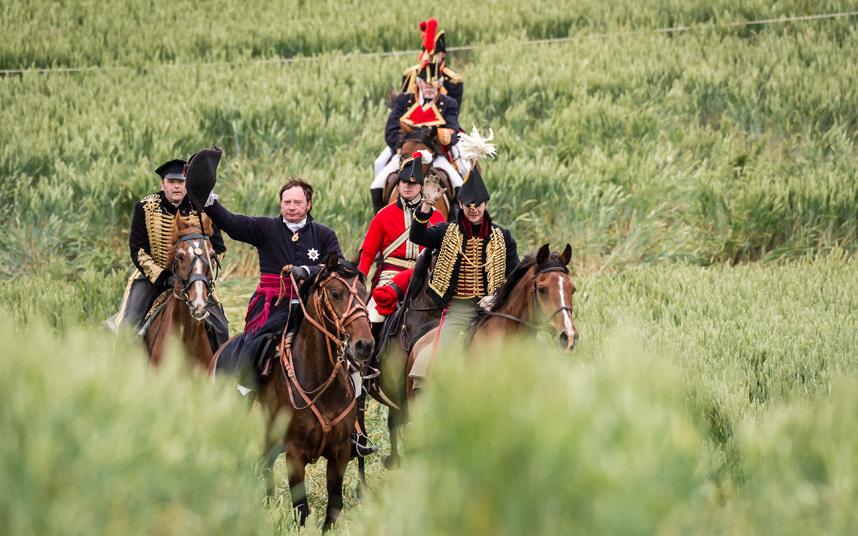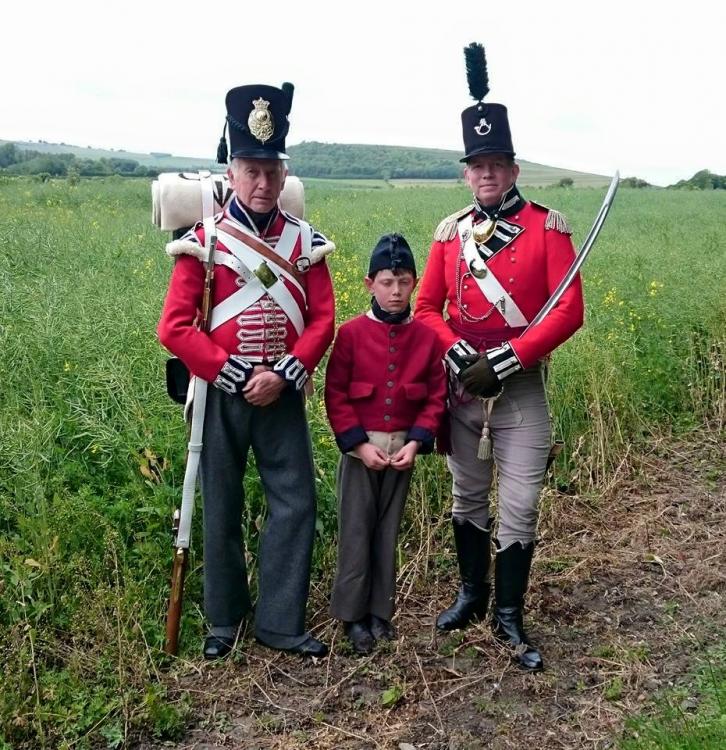
jf42
-
Posts
207 -
Joined
-
Last visited
-
Days Won
1
Content Type
Profiles
Forums
Blogs
Gallery
Events
Store
Posts posted by jf42
-
-
Brett - not sure about the hanoverians, but I suspect yes. There were all sorts of Allied units including a Swedish regiment - mostly composed of Finns in fact - in one of the Allied Brigades. The North American Battalion, of which I had the honour to be an staff officer, was attached to the british 4th Brigade, which also had an attached BBC camerman, so an inordinate number of the shots aired on the BBC in fact showed Canadians, as well as the 2/95th Rifles, the 33rd Foot and the Coldstream Guards, who were brigaded with us. As we also had the only Corps of Drums in the Allied force, they got their share of publcity as well and were employed virtually non-stop, both on and off the field. Sadly, while I was present for the Friday night battle, I went down with food poisioning immediately afterwards and spent 24 hours sleeping, including through the Saturday battle. A few phots attached below. One of our officers and his son, the staff officers inside Hougomont Farm, where we were trapped for an hour by a broken ramp onto the filed, hand to hand combat, His grace the Duke and our Brigade commander, Rob Yuill, with his sone and his father [76] who here portrays their ancestor, a soldier of the Royal Scots. He fell in with the RS in our battalion for the raining sesions.
Some fine images, peter, particularly of 'The Duke' on his rearing horse. I was curious. Who are those fine fellows (third from top) in bearskin caps with blue and white feathers, red coats and white pantaloons, attacking the British square?
The second to last picture shows Ensign Charles Ewart of the Royal North British Dragoons (Scots Greys) presenting the regimental eagle of the 45e Régiment de Ligne (45th Regiment of the Line) he captured.
It looks like that wounded infantryman is trying to steal the cavalry's thunder! I believe Charles Ewart, a Sergeant in the 2nd RNB Dragoons at the time of the battle, was commissioned after the war in recognition of his capture of the Eagle at Waterloo.
Here is a brief BBC news item on a recent exhibition at Edinburgh Castle
0 -
Thanks Paul. I shall pass that on to the interested party.
JF
0 -
Leigh, a very atmospheric memento. Presumably, it dates from the early 'sixties after National Service had ended (so they tell me....) and before the "Join The Professionals" campaign.
I was interested in the notion of the LF's hackle being a battle honour- which would properly would belong on the colours, would it not?. Which action was it asscociated with? I believe the Lancashire Fusiliers earned two battle honours between 1881 and 1914- Sudan and Ladysmith, is that correct?
I am wondering whether, if it was connected with field service, it would be more likely to be a commemorative distinction- which is a different thing. The yellow of the Lancashire Fusiliers hackle, I believe, comes originally from the facing colour of the former XX regiment which became the Lancashire Fusiliers in 1881. I am not sure that the new Fusilier regiment wore a primrose brush plume on their Fusilier caps from the very first. I have a feeling that initially the only Fuslier regimet to wear such a distinction was the Northumberland Fusiliers, whose bicoloured hackle plume, as we know, derived from the defence of St Lucia in 1778. A number of headgear distinctions worn by British regiments were claimed as awards for specific actions: the Black Watch, the Glosters, and the Northumberland Fusiliers, to name but three, but in each case they were commemorative emblems or trophies adopted autonomously by the regiments in times of weak central authority and then authorised or recognised retrospectively by the powers that be ( in 1822, 1824 and 1824 respectively in the case of the 42nd, 28th and 5th).
From 1914 until after the Second World War, there would have been no fusilier plume (except for officers wearing Levee Dress and perhaps in the Wolseley helmet on tropical stations). The small hackle feather plume was an innovation adopted for the beret post war, which appears to have been borrowed from the Scots regiments, who in emulation of the Black Watch had begun to wear cut-down version of the C19 hackle in their blue Balmorals and khaki Tam o' Shanters. The wearing of the Lancashire Fusilier hackle to the left side of the head might be more to do with the position of the regiment''s Fusilier distinction as had been worn on the Full Dress racoon skin cap cap.
0 -
A smart example Mervyn, with a satisfying personal angle. I have my grandfather's pre-1914 feather bonnet in storage, afraid to let it out for the moths pounce on.
I think the black ribbons were standard to all feather bonnets. They represented the adjustable ribbon found on the original flat Scotch bonnet as well as on the Glengarry and some Balmorals. It represented today by a silk bow at the back of the khaki 'Tam o' Shanter.'I suspect the reference to the death of Queen VIctoria is one of those 'reverse engineered' explanations that have been applied to various details in the uniforms of British regiments and their former colonial affiliates.
0 -
I've checked "Britain's Sea Soldiers. a History of the Royal Marines" by Col. G. Field. RMLI. ( 3 volumes, published 1924, )'hoping to find reference to Shipton. but can't.
Interesting mention of an old Marine Private , Johm Sudbury recording Napoleon''s boarding of HMS Bellaraphon on 15 July 1815_ and a claim that a young Napoleon applied for a commission in the British Marines.
I wonder if his transfer to to the 4th King's Own was so far advanced that by June 1815 it was merely a matter of the paperwork being completed and, although his commission as Ensign was not recorded until August 1815, he was no longer regarded as Royal Marines personnel.
0 -
Here is the Wikipedia page on him. https://en.m.wikipedia.org/wiki/Henry_Noble_Shipton
There are several unfounded statements there but it provides a general outline of Shipton's short life. Survived Waterloo at 17. DIed of fever in the W.Indies at 23.
0 -
The 49th Foot amalgamated with the 66th Foot in 1881 to form the Berkshire Regiment & following other amalgamations & changes of title was in 2007 amalgamated into a new regiment, The Rifles.
I understand that at one stage, I think post-1918, the Royal Berkshire Regiment included a coil of rope in its China Dragon cap badge to commemorate the 49th Regiment's period of service as marines with the Royal Navy.
On another Royal Marines topic. Is anyone familiar with the story of Henry Shipton, the only Royal Marine to receive the Waterloo medal? He was present in the battle with the 4th King' s Own, having been attached to the 4th in 1814 when in North America and with his transfer from the Marines to the Army as an Ensign in the 4th KO imminent.
0 -
Good luck. Those collar badges will be key to identifying the regiment
0 -
Robert, I took the liberty of posting your photo here, on http://www.victorianwars.com/viewtopic.php?f=19&t=10293&p=51847#p51847
There are indications that the subject might be a Connaught Ranger, although the collar badges and belt buckle contradict that assessment. They should feature an elephant insignia and it's fairly plain that they don't- whatever else the symbols might be. All other red-coated Irish regiments of the period were Royal regiments, several being Fusiliers as well, and we don't see the relevant uniform details in your photo (By the way I mispsoke about the relative size of the cap badge, which should be about 3 inches high. The cap worn by John Kelly has been cut down to create a more jaunty look off-duty).
The identification with the Connaught Rangers is complicated by the fact that neither the 1st or 2nd Battalion of the regiment was stationed at the Curragh, or even within 100 km, during the 1880s and 1890s and neither were in Ireland between 1885 and 1897. The 1st Battalion were stationed at Athlone between 1897-99, which is a little late for John Kelly's participation in the Spanish-American war.
It's been suggested he might have been in a Militia unit and that proposition remains to be explored.
I quote from a Victorian Wars Forum member's comments:
"The harp was associated with many units in Ireland as you know and would predicate a militiaman. Regulars had long been in the universal union clasp by then.
Three out of the four militia battalions for the Connaughts wore a variation of the harp, Erin, or angel*. Roscommon militia thought to have done so several years after the merger**."
* "Erin, or angel" refers to different versions of the Harp emblem used in the badge of the Connaught Rangers at different times, the latter having its front formed of a winged angel. The Erin harp, so-called, being plain
** "The merger" refers to the union in 1881 of two Irish regiments, the 88th and the 94th to form The Connaught Rangers. This was part of widespread reforms that created two-battalion regiments attached to specific districts of the United Kingdom with local militia and volunteer regiments attached and incorporated as battalions of the 'parent regiment.' The 88th had traditionally recruited in the southwest province of Connacht.
None of the above explains what John Kelly was doing having his photo taken at the Curragh of Kildare- which, in case you didnt know, was a principal British Army garrison to the southwest of Dublin but the Connacht Rangers were never stationed there in the 1880s or 1890s and had their regimental depot in Galway far to the southwest. Perhaps he was there with his militia battalion on annual camp.
Roscommon, by the way, is not so far from Moate, West Meath, one of the birthplace options for John Kelly. Dublin, the other option, is more handy for the Curragh of Kildare.
I hope at least some of that information will help you in refining your g'grandfathers biography.
ATB.
0 -
Your G'grandfather's Irish origin and the photo being taken in a studio at the Curragh don't necessarily mean that he was in an Irish regiment. The Glengarry bonnet he is wearing dates the photo to before about 1896 when a new Field Service cap finally replaced the Glengarrywhich was phased out from 1894 for all but Scottish regiments. His apparent youth would place the date earlier rather than later, as you say, perhaps circa 1890.
That's a particularly large badge to be worn on the Glengarry - they tended to be smaller than that except in Scottish regiments. That should narrow down the options somewhat, as will what may be yellow or orange facings on the cuffs and collar of his tunic, which show up dark as a result of the photographic process of the time. If you can make an enlarged image of the collar badge that might help too.
If you post the picture on http://www.victorianwars.com/index.php you will get some much more precise observations on the points raised above and with luck get closer to identifying the regiment. In addition, your man's name should turn up on all sorts of records relating to his service.
0 -
Very interesting, Simon. Through how many Patterns did they retain the poacher's pocket in the lower back portion of the smock?
0 -
Can one have an epaulette in the middle of one's chest?
0 -
Certainly, the badger head and five tassles are A&S Highlanders style, bullion cords to the tassels being for officers levee dress. While Full Dress was suspended in 1914, Dress Regulations were renewed in 1934 and officers required Full Dress items for levee dress, including the sporran. Items of 'Victorian' vintage, that is pre-1901 (approximately) will have the Queen Victoria crown wherever that symbol is shown on badging and other appointments. That's not to say items might not be handed down and such details winked at in certain instances.
0 -
I dont feel the look on the Cameronian Colonel's face could be faked.
0 -
The Mark III was more common among troops that had been training in Britain in the years running up to the Normandy landings and I have the impression, from photos, it saw particularly widespread use among Canadian units. The 51st Highland and 7th Armoured Divisions, joining the invasion force later on, having previously been in the Mediterranean theatre, may not have been issued with it so widely. By 1945, as the photo indicates, there seems to have been a fair amount of mix and match within units across the board.
0 -
If you haven't done so already, you might try posting an enquiry here :
0 -
I'm afraid I can't. I wasn't aware they did. I only knew Rifles drill.
Simple answer? The regimental system!
0 -
Correction, that should read "Green Jackets Museum, Peninsula Barracks, Winchester." Sir John Moore Bks is the johnny-come-lately establishment just outside town.
0 -
Interesting observations, Tony- particularly your last as to why anyone would have gone to the effort of creating such a distressed item.
Developing the theatrical theme, could this have been a locally made instrument decorated or re-decorated for some kind of pageant in the C19th?
0 -
I can't comment on the construction or age of the drum, except to agree that it's palpable antiquity is almost too convincing.
As for the artwork, I am 100% convinced that is the product of a theatrical art department or similar. The brushwork on the thistles and crown is too impressionistic, that is, intended to look convincing from a distance. That is not how designers and craftsmen worked in the pre-petrochemical age.
If this is artefact is in some way meant to be associated with the House of Atholl, one only has to look at the actual arms of the Duke of Atholl, quartered almost out of all existence, and it isn't hard to see why a designer might have decided that it was too much work to reproduce something that just wouldn't ' read' from a distance and so went for a monogram instead. My guess is 1900-1950- give or take ten years.
PS Here are links to a genuine mid-C18th monogram of the Duke of Atholl:
http://www.worthpoint.com/worthopedia/1758-isle-man-duke-atholl-2d-half-281783151
0 -
Dan, it's an interesting question and one that puzzled me when as a boy I lived just down the road from the Rifle/ RGJ depot in Winchester.
I can't quote you chapter and verse from the post-war period but clearly the historic relationship between the 43rd and 52nd and the riflemen of the 95th and 60th was a factor. The 43rd and 52nd were the first infantry regiments officially designated as light infantry and to train at Shorncliffe under John Moore. Whether they thought that set them apart from the 53rd and 68th LI as well as the johnnie-come-lately 13th and 32nd LI- (both awarded as their titles as an honorific for service in India in the years following the Napoleonic Wars), I couldn't say for sure.
Similarly, when the 43rd and 52nd were joined to form the Oxfordshire and Buckinghamshire Light Infantry in 1881, the new regiment may have regarded itself as a cut above the other Light Infantry regiments created by the Childers Reforms, having a 'purer' pedigree than the DCLI, KOYLI & DLI, each of which- apart from the 13th who already had two battalions- had been joined either with non-LI or very junior LI regiments that had been part of Honourable East India Company's Army until the Great Mutiny.
Being effectively a Home Counties regiment, the 'Ox & Bucks' LI was a regiment with greater social cachet than the other LI and doubtless felt they had more in common with the socially elite RIfle Brigade and King's Royal Rifle Corps. So it would have been a natural move for them initially to be brigaded with the two rifle regiments in 1948 and, when the time came for amalgamation, to become the 1st Battalion, the Royal Green Jackets would have been seen as the lesser of two evils.
That is me thinking aloud. If you would like a slightly sanitised (with reference to regimental snobbery) but more authoritative version, I reccommend you contact the very helpful Green Jackets Museum still housed at Sir John Moore Barracks in Winchester.
Hope that's of some use.
0 -
I don't imagine fixing on a green tunic ( but, indeed, not Rifle green) would have been that difficult for the various Light Infantry regiments, given the clear distinguishing effect and its history as a distinguishing colour.
British Light Infantry companies in America informally adopted a green hat feather as a distinguishing emblem when detached from their parent regiments to fight in 'Flank Battalions during the War of Independence. This custom was brought back from America and, despite being non-regulation, was adopted fairly widely among troops at home. although green was not always the distinguishing colour used. The distinctive Light Infantry cap was only worn on special occasions while the hat was worn for every day service. Similarly, grenadiers had adopted a white hat feather in America, with their bearskin caps usually kept in store. The distinguishing feathers served to identify the flank coys in everyday service. The ostrich feather of the AWI period was soon superceded by an upright hackle plume, with a worsted 'tuft' sometimes used as a substitute.
Finally, in an attempt to bring the un-official use of regimental hat feathers in the infantry, by both flank companies and battalion companies, an order was issued in 1797 specifying a white-over- red feather for battalion companies and staff, a white feather for grenadier coys and a green feather for light infantry companies. This met with limited success. When the shako was adopted in 1800 the same system was ordered more emphatically with severe consequences for commanding officers who did not comply or allowed deviations from the norm. With a few exceptions- for instance, the Fifth (Northumberland) Regiment and the 42nd Royal Highland Regiment, this was successful. With the shako, a hackle feather plume was worn by officers and a worsted 'tuft' by other ranks.
A green 'feather' was ordered for both Light Infantry and Rifles. In 1829 this changed to a green 'ball tuft.' which changed briefly in 1855 to a hanging horsehair plume for Light Infantry Regiments. In 1858 flank companies began to be phased out in Line Infantry regiments. With the adoption of the cloth-covered home service helmet in 1878, cap distinctions became obsolete. Light infantry were thenceforth identified in full dress by green helmets, as you have pointed out. During the Boer War, I believe, certain Light Infantry regiments used green flashes on the khaki covers of their Foreign Service helmets. With the introduction of Khaki Service Dress, and the suspension of Full Dress in 1914, the situation became more diffuse. We can only start generalising again after 1945.
0 -
We might also ask why the regiments of the Highland brigade adopted doublets of Piper green. I think the answer may lie in the fact that, although the Blue patrol frock of the pre- 1914 period was very smart, when worn en masse by troops it had a very sombre effect. It was not entirley popular. Apparently when the blue Coronation dress was ordered for the Coronation of George VI in 1937, there were comments that it made troops look like postmen.
I think quite simply, the light infantry brigade adopted green tunics because it had been the light infantry distinguishing colour since the late C18th and the opportunity was there.
0 -
You're welcome. T.F. Mills is not infallible; the monumental work was never completed before some idiot hijacked his domain name. So there are errors and question marks in some of the service record charts, but it's always a good starting point.
0







Yesterday at Waterloo...
in Napoleonic Wars
Posted
Sorry, the URL wouldn't load. 21st century- tsuh!